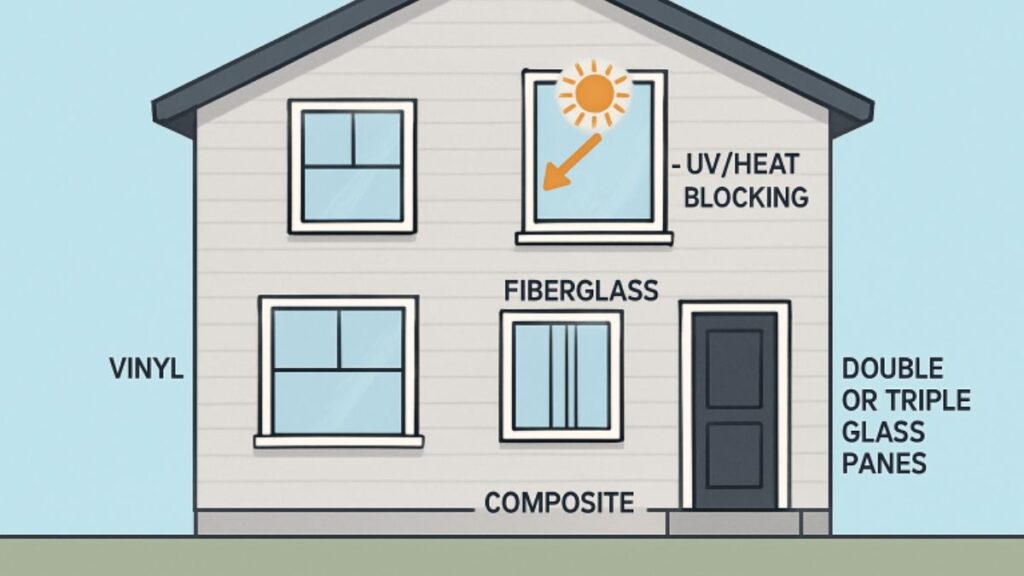As energy costs and environmental awareness rise, more homeowners seek solutions that make a difference. Upgrading to energy-efficient windows offers an effective way to cut utility expenses while also improving the comfort and sustainability of your living space. With climate change impacting weather patterns and utility rates, homeowners need to look for upgrades that yield measurable results in reducing their carbon footprint and overall living costs. Consulting a local window contractor can ensure professional guidance and installation for lasting results for those ready to take the next step. An experienced contractor can evaluate your current windows, recommend the most effective products for your region, and carry out proper installation, giving you peace of mind for years to come.
Modern advancements in window technology have given rise to a broad range of options, allowing homeowners to select products tailored to their specific energy needs and design preferences. Whether your priority is improved insulation, innovative control of sunlight, or eco-friendly materials, there’s a solution that fits your lifestyle and budget. Today’s windows are available in a wide array of designs—from classic double-hung or casement styles to contemporary fixed-pane or picture windows. Coupled with customizable finishes and hardware options, energy-efficient windows can enhance your home’s curb appeal, contributing to its market value and aesthetics.
Understanding Energy-Efficient Windows
Energy-efficient windows are engineered to minimize heat transfer between the indoors and outdoors, keeping interiors warmer in the winter and cooler in the summer. This improvement stems from advanced features such as multiple glazing layers, specialized coatings, and gas fills—typically argon or krypton—between glass panes. These components are designed to work together, reducing the strain on heating and cooling systems throughout the year. For instance, double- or triple-glazed windows create an insulating barrier that helps your home maintain a consistent internal temperature, reducing energy spikes during seasonal transitions. According to the Department of Energy, high-performance windows can significantly impact a home’s energy profile, especially in areas with extreme seasonal temperatures. In addition to comfort and efficiency, these windows often provide better soundproofing than traditional single-pane windows, making your home quieter and more peaceful.
Advancements in Window Technology
In recent years, there have been remarkable innovations in residential window technology, each designed to enhance thermal performance and occupant comfort. Homeowners now have a variety of advanced features to choose from, many of which were not widely available just a decade ago:
- Low-Emissivity (Low-E) Coatings: These nearly invisible layers on the glass surface reflect infrared heat, reducing the heat entering or leaving your home while letting in visible light. As a result, indoor temperatures remain more consistent, and energy bills shrink. Low-E coatings also help protect interior finishes from harmful UV rays, reducing the fading and deterioration of floors, fabrics, and furniture.
- Smart Glass Technology: Utilizing electrochromic glass, these windows adjust their tint in response to sunlight intensity, decreasing glare and unwanted heat gain. This dynamic tinting technology enables greater control over indoor climate, even on the brightest days. Some innovative glass systems can be controlled remotely from your smartphone, allowing you to set schedules or instantly adjust settings for privacy or energy savings with a button.
- Vacuum-Insulated Windows: By creating a vacuum between the panes, these advanced windows provide exceptional insulation without increasing thickness, making them suitable for sleek, modern home designs. This window type is especially ideal for passive homes and renovations where exterior wall space is limited but energy performance is a high priority.
Choosing the Right Frame Materials
The construction and materials of window frames play a vital role in determining overall energy efficiency. Select from a range of options, each with unique benefits, and consider factors such as durability, maintenance requirements, and how the frame will perform in your local climate. A well-chosen frame can also enhance aesthetics and security:
- Vinyl Frames: Economical and low-maintenance, vinyl frames deliver sound insulation and weather resistance, making them a popular choice for many homeowners. They resist corrosion, chipping, and fading, maintaining their appearance without routine painting or refinishing.
- Fiberglass Frames: Exceptionally durable and resistant to temperature swings, fiberglass frames provide outstanding thermal performance and are well-suited to various climates. Their structure resists warping and swelling, ensuring windows operate smoothly for years. Fiberglass can often be painted to match your home’s decor, offering both performance and versatility.
- Composite Frames: Combining the natural charm of wood with cutting-edge material engineering, composite frames achieve high insulation values and impressive longevity. These frames are typically manufactured from a blend of wood fibers and polymer resins, giving homeowners the look and feel of wood without the traditional drawbacks such as rot, warping, or termite damage.
Installation Best Practices
Even the most advanced windows will fall short of expectations without proper installation. Key best practices include ensuring a tight seal around the frame, correct alignment, and thorough testing for air leaks. Precise installation is essential for energy performance and avoiding issues like condensation between panes, operational problems, and water intrusion. Qualified installers can identify structural nuances and prevent energy loss, ultimately enhancing thermal performance for years. They can also check for and remedy related issues, such as poor insulation in surrounding wall spaces or previous installation errors. Verify credentials, seek references, and ensure your installer adheres to the manufacturer’s instructions to safeguard your warranty and investment.
Financial Incentives and Savings
Investing in energy-efficient windows often qualifies homeowners for substantial utility savings and attractive government incentives. For example, the Inflation Reduction Act of 2022 enables property owners to claim up to 30% of the costs for qualifying energy-efficient windows and doors through federal tax credits. These credits are a powerful way to offset initial project expenses, making long-term savings more attainable for families. Additionally, many state and local governments offer rebates and financing programs to offset upfront expenses, making energy-smart upgrades more accessible. Utility companies in some regions provide additional discounts or “green lending” opportunities, further easing the path toward a home upgrade. Over time, the combined effect of incentives and ongoing monthly savings can help homeowners recoup their investment while enjoying greater comfort and efficiency.
Environmental Impact
Beyond their financial benefits, energy-efficient windows support global environmental efforts by lowering household energy consumption and reducing greenhouse gas emissions. By improving your home’s thermal envelope, you contribute to a reduction in fossil fuel usage and help decrease pollution from power plants. These upgrades help households align with international sustainability goals, contribute to less reliance on fossil fuels, and promote a healthier, greener future for communities worldwide. Adopting efficient windows, combined with other energy-saving home improvements, multiplies the environmental benefit—less energy use translates into fewer resources needed and lower emissions for everyone. Even small energy-saving changes in the home can make a meaningful environmental impact over time.
Conclusion
Adding energy-efficient windows to your home is a forward-thinking investment that delivers comfort, cost savings, and fundamental contributions to climate sustainability. With advancements in glass technology, frame materials, and installation practices, it’s easier than ever to tailor an upgrade that fits your home’s architecture and your family’s needs. In an era where energy efficiency is closely tied to property value and long-term savings, these upgrades stand out as one of the highest-return improvements you can make. Professional advice from a qualified installer can help ensure optimal results and bring peace of mind as you enhance the efficiency and value of your property.





